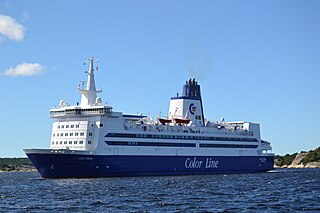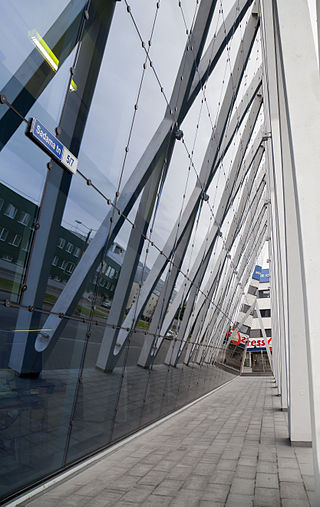
MS Gabriella is a cruiseferry sailing on a route connecting Helsinki, Finland and Stockholm, Sweden for Viking Line. She was built in 1992 in Brodosplit, Croatia as Frans Suell for service with Euroway. Between 1994 and 1997 she sailed as Silja Scandinavia for Silja Line. Gabriella has sister ships Mega Victoria operated by Corsica Ferries, Isabelle operated by Tallink, and a third one, Crown Seaways, operated by DFDS Seaways.

Color Line AS is the largest cruiseferry line operating on routes to and from Norway. The company is also one of the leading operators in Europe. Color Line provides transportation for people and cargo, hotel accommodation, shopping, restaurants and entertainment. The company currently employs 3500 people in four countries.

Swedish American Line was a Swedish passenger shipping line. It was founded in December 1914 under the name Rederiaktiebolaget Sverige-Nordamerika and began ocean liner service from Gothenburg to New York in 1915. In 1925 the company changed its name to Svenska Amerika Linien / Swedish American Line.

MS Vana Tallinn was a cruiseferry owned by the Estonian ferry company Tallink and operated on the line between Kapellskär and Paldiski. She was built in 1974 by Aalborg Skibsværft AS, Aalborg, Denmark for DFDS as MS Dana Regina, and has sailed under the names MS Nord Estonia and MS Thor Heyerdahl.

The MS SuperStar II is a ferry owned by the Greek/Cypriot Seajets, and operated on their service between Sandefjord and Strömstad from 16th June 2000 until 20th November 2022. She was built in 1985 as MS Peder Paars by Nakskov Skibsværft, Nakskov, Denmark for DSB Færger. Between 1991 and 2000 she sailed as MS Stena Invicta for Sealink Stena Line and Stena Line. In 1998 she was chartered to Silja Line under the marketing name MS Wasa Jubilee. In May 2000 the Stena Invicta started operating for Color Line and received the name MS Color Viking.

Moby Zazà is a ferry operated by Moby Lines between Nice and Bastia. Until 2015 she was MS Wind Perfection, an accommodation ship owned and operated by C-bed. She was built in 1982 as MS Olau Britannia by Weser Seebeckswerft in Bremerhaven for Olau Line, who used her on Sheerness—Vlissingen service. In 1990 she was sold to Fred. Olsen Lines and renamed MS Bayard for services between Norway and Denmark. In 1991 Fred. Olsen Lines was sold to Color Line and the Bayard passed under their ownership under the name MS Christian IV. In 2008, she was sold to Stella Lines and renamed MS Julia for service between Helsinki and St. Petersburg. This was a failure and after just two months the Julia was laid up. In 2009, she was sold to Fastnet Line and entered service on their Swansea—Cork route in 2010, retaining her earlier name.

Moby Corse is a ferry owned and operated by Moby Lines. She was built at Aalborg Værft A/S in Denmark for DFDS Seaways as MV Dana Anglia and entered service with them in 1978. She sailed between Esbjerg, Denmark and Harwich, United Kingdom between 1978 and 2002 before being renamed MV Duke of Scandinavia for service between Copenhagen, Denmark and Gdańsk, Poland. She returned to the North Sea in 2003 to sail between Newcastle and IJmuiden.
Renaissance Cruises was a cruise ship operating company that was founded in 1989 and owned by Fearnley & Eger Rederi in Oslo, Norway. It was purchased by Edward Rudner as the company faltered during the Gulf War. It operated year-round cruise itineraries to the Mediterranean Sea, the Greek Isles, Tahiti and the South Pacific, northern Europe and Scandinavia. The company ceased operations on 25 September 2001, having accommodated up to 220,000 guests in 2000. While the company had been in poor financial health for quite some time, the economic decline resulting from the September 11 attacks in 2001 is credited with the demise of this cruise line. It was headquartered in Fort Lauderdale, Florida.

MS Pearl Seaways is a cruiseferry owned by DFDS Seaways and operated on their Copenhagen–Frederikshavn-Oslo service. She was built in 1989 by Wärtsilä Marine, Turku, for Rederi AB Slite as MS Athena for use in Viking Line traffic. Between 1993 and 2001, she sailed as MS Langkapuri Star Aquarius. From 2001 to 2011 she sailed as MS Pearl of Scandinavia.

MS Moby Otta is a cruiseferry, currently owned by the Italy-based shipping company Moby Lines and operated on their Genoa–Olbia service. She was built in 1976 by Flender Werke, Lübeck, West Germany as MS Tor Scandinavia for Tor Line. Between 1991 and 2006 she sailed as MS Princess of Scandinavia.

The Hansa class is a class of four ro-pax ferries originally built by Stocznia Gdańska, Poland for Finncarriers-Poseidon service. Following a merger of Finncarriers and Poseidon to Finnlines, all ships of this class came to be owned by Finnlines. As of 2013, three ships are operated on Finnlines' routes connecting Finland and Sweden to Germany, while two ships sail with Grimaldi Ferries in the Mediterranean.

MS Superspeed 1 is a fast ro-pax ferry owned and operated by Color Line. She was built by Aker Finnyards, Rauma, Finland in 2008, and entered service on the Kristiansand—Hirtshals route on 13 March 2008.

The Belorussiya-class was a class of cruiseferries that were built by Wärtsilä Turku Shipyard, Finland in 1975–1976 for the Black Sea Shipping Company, Soviet Union. The five ships in the class were originally used in cruiseferry service around the Black Sea. During the 1980s all ships in the class were rebuilt into cruise ships. During the end of the 1990s all ships in the class were sold to other operators. The remaining ships in this class ended service in 2020. All ships as of 2022 have been scrapped except for the Enchanted Capri, which was shipwrecked on the Gulf coast of Mexico and only has partially been dismantled.

MS GNV Cristal is a cruiseferry owned by the Italy-based SNAV and operated by their Grandi Navi Veloci brand. She was built in 1989 by Schichau Seebeckwerft in Bremerhaven, West Germany as MS Olau Hollandia for Olau Line. From 1994 to 2005 she sailed as MS Pride of Le Havre for P&O ferries. From 2005 to 2017 she operated as the SNAV Sardegna between Civitavecchia, Palermo and Olbia.

Mega Express Four is a fast roll-on/roll-off ferry owned by Corsica Ferries - Sardinia Ferries and operated on their routes from Nice and Toulon to Ile Rousse. She was built in 1995 by Schichau Seebeckwerft in Bremerhaven, Germany for Superfast Ferries as Superfast II. Between 2003 and 2006 she sailed for TT-Line as Spirit of Tasmania III.

MS A Nepita is a fast ropax ferry for Corsica Linea. The ferry was refurbished in Gdańsk, Poland for her new service and was returned to her original design before her SeaFrance career and looks identical to her sisters Stena Superfast VII & VIII. Before November 2014 she operated between Dover and Calais for DFDS Seaways France and between 2008 and 2012 for SeaFrance.

MS Ancona was a car-passenger ferry owned by Blue Line International and operated on it service linking Ancona in Italy to Split, Croatia. She was built in 1966 by Lindholmens varv in Gothenburg, Sweden, for Rederi AB Svea as MS Svea. As Svea, she was used on the joint Sweden–United Kingdom service operated by Ellerman's Wilson Line, Swedish Lloyd and Rederi AB Svea. In 1969 Svea was sold to Swedish Lloyd and renamed MS Hispania. In 1972, she was renamed MS Saga. In 1978, she was sold to Minoan Lines following the closure of Swedish Lloyd's passenger services and renamed MS Knossos. In 1998, she passed to Diler Lines, becoming their MS Captain Zaman II. In 2003, she was sold to Blue Line and was renamed Ancona. She was sold for scrap in October 2010 and breaking up was commenced on 15 December 2010.

The GNV Atlas is a Peter Pan-class cruiseferry currently owned and operated by the Italian shipping company SNAV. She was launched on 28 October 1989 by Schichau Seebeckwerft in Bremerhaven, West Germany as Olau Britannia for Olau Line.

MS Moby Drea is a cruiseferry, currently owned by the Italy-based shipping company Moby Lines and operated on their Genoa–Olbia service. It was built in 1975 by Flender Werke, Lübeck, West Germany as MS Tor Britannia for Tor Line. Between 1991 and 2003 it sailed as MS Prince of Scandinavia.




















